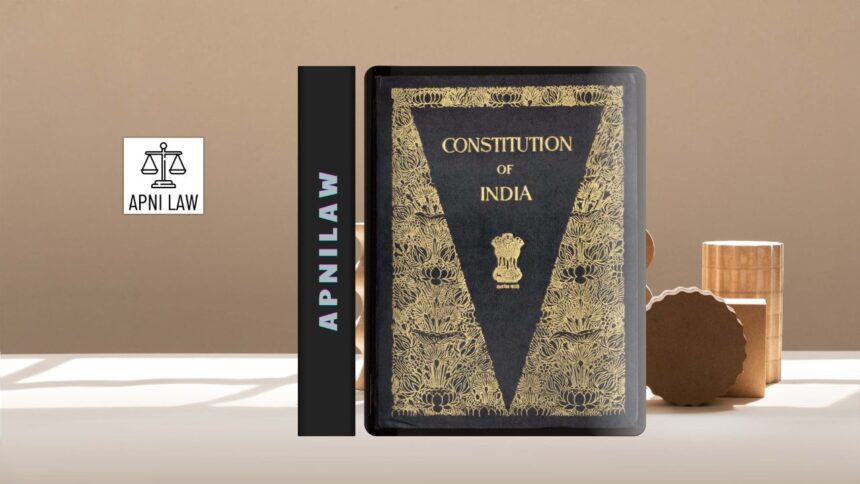Introduction
Article 1 of the Indian Constitution is most important in defining India’s political identity and territorial organization. Article 1 states, “India, that is Bharat, shall be a Union of States.” This concise but crucial statement articulates the entire concept of Indian federalism. It not only mentions the name of the country but the character of its federal framework also. The designation of the term “Union of States” instead of “Federation of States” was with a definite political motive. It is a befitting tribute to the vision of the founders to make India one and at the same time protect its diversity. In this article, we will discover what Article 1 is all about, why the term “Union” was used, and how it impacts Indian governance.
Text of Article 1
The verbatim version of Article 1 is as below:
(1) India, that is to say Bharat, shall be a Union of States.
(2) The States and the territory of each of such States shall be as specified in the First Schedule.
(3) The territory of India shall include –
(a) the State territories,
(b) the Union territories specified in the First Schedule, and
(c) such other areas as may be acquired.
In this paragraph, three principal things are clearly defined. One, it proclaims the name of India to be India and Bharat. Two, it mentions the Union to be composed of states and Union territories enumerated in the First Schedule. Three, it provides for India to gain new land in the future. These provisions confirm that India comprises various states but there is no provision for any state to attain independence.
Why “Union of States” And Not “Federation of States”?
The Constitution framers employed the phrase “Union of States” deliberately in lieu of “Federation of States.” This was done to express the fact that India is an indissoluble union of collapsible states. This means that states cannot leave the Indian Union at all. Following the traumatic Partition experience of 1947, the framers were eager for India to be united and strong.
Dr. B.R. Ambedkar clarified in the Constituent Assembly that the term “Union” means that Indian federation is not the outcome of a voluntary union between the states. Rather, it is something designed by the Constitution itself. The states are not independent units other than the Constitution, and they can’t leave the Union. It is not like the example of states of the USA, where states voluntarily joined to create a federation.
What Are The Implications of Article 1
Article 1 has significant implications for the government of India. Article 1 makes India a federal state with a strong unitary orientation. The States have autonomy in certain areas, but the Union government has more powers, particularly when it comes to dealing with emergencies. The Parliament can reorganize a state, change boundaries, or even form new states by law under Article 3 of the Constitution. This dispensation has enabled India to evolve according to linguistic, cultural, and administrative needs over the years.
The term “Union of States” also expresses the policy of national integration. It guarantees that in spite of diversity, India remains one political entity. This oneness is necessary to maintain stability and avoid secessionist forces in a country as vast and diverse as India.
Territorial Structure Under Article 1
Article 1 divides India’s territory into three classes:
The areas of the states.
The Union territories specified in the First Schedule.
Any other area which comes into India.
India now consists of 28 states and 8 Union territories. Union territories are directly governed by the Central Government, but a few of them like Delhi and Puducherry have their own legislatures. This provision for the inclusion of new territories through annexation has been used in the past when Goa, Daman and Diu, and Sikkim were added to India.
Role of the First Schedule
The First Schedule has a strong link with Article 1 of the Constitution. It mentions all Union territories and states along with their territory jurisdiction. Any modification in the name, boundary, or status of a state is brought about through an amendment in the schedule by a law enacted by Parliament. All such modifications in India’s political map take place legally rather than arbitrarily under this constitutional provision.
Historical Background of Article 1
The background to Article 1 was post-Independence India’s predicament. Integration of more than 500 princely states was a mammoth task for the Constituent Assembly. The bogey of disintegration and fragmentation ruled. The employment of “Union” over “Federation” was because of the apprehensions. It gave immense power to the Union government to give territorial integrity and to guard against any attempt at secession.
Judicial Interpretation of “Union of States”
The courts have never relaxed the primacy of the Union. In the State of West Bengal v. Union of India case of 1962, the Supreme Court emphasized that India was neither an agreement federation but a union created by the Constitution. States are neither sovereign nor secessionary. In the same way, in subsequent cases, the Court again emphasized that the fundamental structure of the Constitution comprises India’s integrity and unity, and this cannot be changed even through the process of constitutional amendment.
Contemporary Significance of Article 1
Recently, Article 1 remains a crucial provision to maintain the unity of the nation. Abrogation of Article 370 in 2019 and Jammu and Kashmir Reorganization Act reorganizing Jammu and Kashmir into two Union territories are illustrations of the exercise of the powers of the Union government under the Constitution. In the same way, the formation of new states such as Telangana was carried out pursuant to provisions of the Constitution under Article 1 and Article 3.
The concept of a “Union of States” also lends support to cooperative federalism, under which both Union and state governments work in tandem for development. In the case of programmes such as GST and national programmes, this frame of mind of working together is crucial for inclusive development.
FAQ
What does Article 1 of the Indian Constitution declare?
It declares India, that is Bharat, to be a Union of States, and fixes its territorial area.
Why is India a Union and not a Federation?
Because Indian states cannot secede from the Union, and the Union cannot be dissolved despite the fact that states can be reorganized.
How many states and Union territories are there in India according to Article 1?
India currently has 28 states and 8 Union territories.
Can new areas be included in India according to Article 1?
Yes, Article 1(3)(c) enables India to include new areas.
What is the importance of the First Schedule in connection with Article 1?
The First Schedule specifies the states and Union territories and their boundaries that are changeable only by way of parliamentary law.
For any specific query call at +91 – 8569843472
Conclusion
Article 1 of the Indian Constitution forms the cornerstone of India’s political and territorial identity. To the extent that it proclaims India to be a “Union of States,” it establishes unity and integrity with diversity. The use of the word “Union” in a positive sense indicates the vision of the framers of a united, invincible nation wherein states are constituent parts of a sovereign nation. Article 1 still forms a part of the federal framework of India today, defining the relationship between the Union and the states and securing the oneness of the nation.







